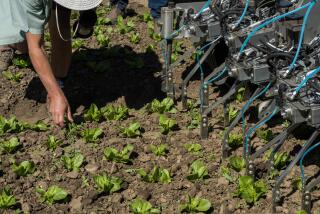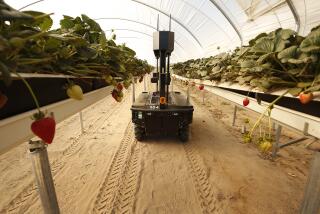Computer Monitoring Boosts Dairy’s Output
- Share via
STANLEY, N.Y. — Some people get e-mail. Don Jensen gets “e-moos.”
Instead of bells, Jensen’s 800 dairy cows wear computer transponders around their necks, enabling weighing meters to measure how much milk each produces. The data feed into a computer in his mud-spattered office.
“We know quickly which cows are making us money and which ones aren’t,” Jensen said. Automatic gates send some to the veterinarian, some to the breeder--and others to the butcher.
And that is one reason why Jensen squeezes four or five times as much milk from each Holstein as his grandfather did in 1925.
The modern dairy may look the same from the highway, but it’s nothing like it was. Today’s 1,500-pound bionic bovines are better bred, better fed and better cared for--and worth their weight in milk every couple of weeks.
As a result, today’s dairy farmers are different creatures, as well.
Ask Jensen. While his grandfather and his father had a hand in all the chores, this 41-year-old dairyman is too busy managing a carefully calibrated operation to even do any milking himself.
“When I was young, it was very relaxed,” he said, in a wistful moment. “But this world sped on! We’re way better off than we were, but I guess it isn’t as much fun. It’s a very fast-moving economy out here.”
It’s gotten much faster for him lately. In 1992, he computerized his milking parlor and went from two milkings a day to three. His herd has grown from 150 to 800--300 of them calves--and he’s taken on eight employees in place of one at his 1,000-acre farm in undulating Finger Lakes country.
Jensen is convinced--and the last half-century bears him out--that many dairy farms that fall behind their neighbors in efficiency won’t be around in another generation. And the indispensable tool of the 21st century, he said, will be the computer.
Jensen’s system cost $50,000 and he believes it has already paid for itself by raising his milk yield per cow by an estimated 5 pounds a day. He gets 25,000 pounds of milk a year from each cow, well above the record statewide average of 15,900 pounds in 1994.
By 1997, he expects to complete the farm’s transformation into one of the most sophisticated and productive dairies in New York, the nation’s No. 3 milk-producing state after California and Wisconsin.
His annual sales have already jumped from $300,000 to more than $1.5 million and profits are edging expenses. But this is no easy field, considering milk prices have climbed less than 75 cents a gallon in the last 20 years.
The cow that gives all that milk is a very different animal. Artificial insemination is one reason. Another is better nutrition, arranged by timing the alfalfa and field corn harvests more accurately.
Add more sophisticated mechanical equipment and medicines to minimize the risk of infection, and you have animals that are 200 to 300 pounds bigger than those of a few decades ago.
Meanwhile, in modern barns, cows are allowed to roam freely, choosing where to eat and sleep, instead of being chained into stalls.
“A contented cow is a more productive cow,” said Bruce Hawley, administrator of the New York Farm Bureau. “It means treating the animal like a gifted athlete.”
Jensen embraces the changes and presses ahead, knowing that his father shared his enthusiasm. He remembers bringing photographs of the newly expanded free-stall barn to the hospital shortly before his father died in December 1994 at age 75.
“One of the last things he said was, ‘It’s beautiful!’ ” Jensen said. “He lay there with the tears running down his cheeks. He lived and breathed the farm. That was his life.”
And someday, Jensen hopes, there will be a robust business to pass along to his son and two daughters.
“There’s two directions every business goes--backwards or forwards,” he said. “Nothing can stand still, unfortunately.”
More to Read
Inside the business of entertainment
The Wide Shot brings you news, analysis and insights on everything from streaming wars to production — and what it all means for the future.
You may occasionally receive promotional content from the Los Angeles Times.










